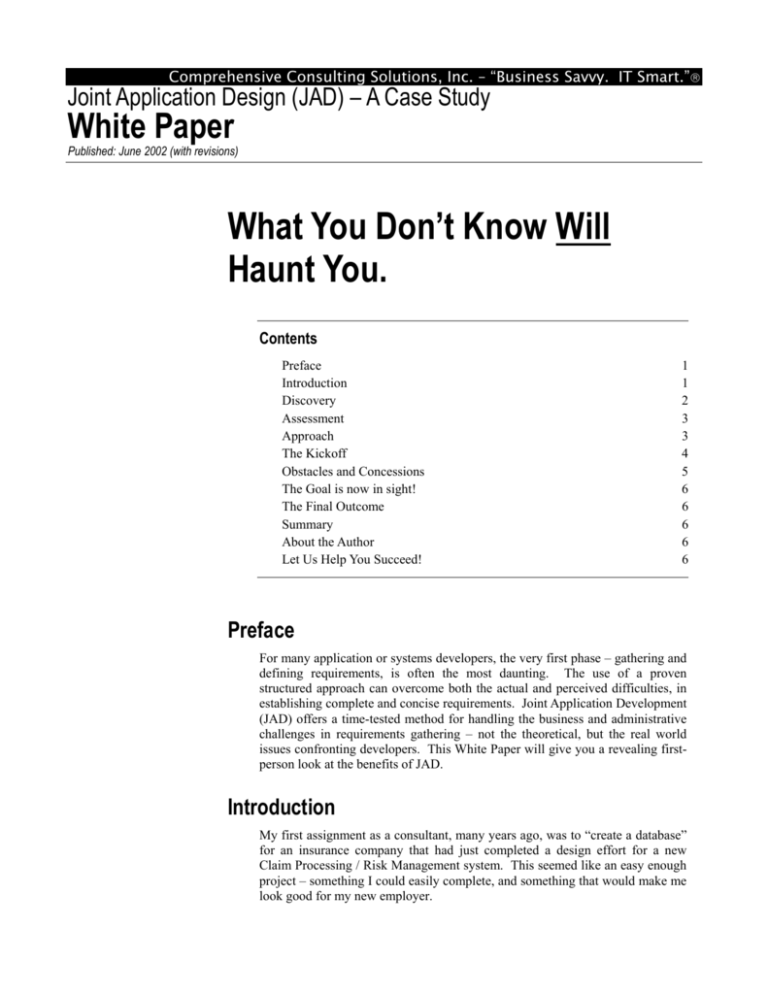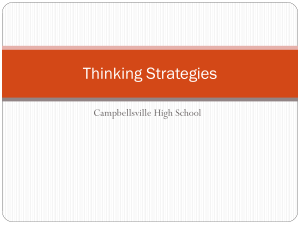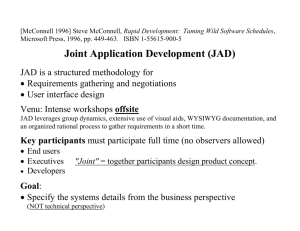
Comprehensive Consulting Solutions, Inc. – “Business Savvy. IT Smart.”®
Joint Application Design (JAD) – A Case Study
White Paper
Published: June 2002 (with revisions)
What You Don’t Know Will
Haunt You.
Contents
Preface
Introduction
Discovery
Assessment
Approach
The Kickoff
Obstacles and Concessions
The Goal is now in sight!
The Final Outcome
Summary
About the Author
Let Us Help You Succeed!
1
1
2
3
3
4
5
6
6
6
6
6
Preface
For many application or systems developers, the very first phase – gathering and
defining requirements, is often the most daunting. The use of a proven
structured approach can overcome both the actual and perceived difficulties, in
establishing complete and concise requirements. Joint Application Development
(JAD) offers a time-tested method for handling the business and administrative
challenges in requirements gathering – not the theoretical, but the real world
issues confronting developers. This White Paper will give you a revealing firstperson look at the benefits of JAD.
Introduction
My first assignment as a consultant, many years ago, was to “create a database”
for an insurance company that had just completed a design effort for a new
Claim Processing / Risk Management system. This seemed like an easy enough
project – something I could easily complete, and something that would make me
look good for my new employer.
2
Joint Application Design (JAD) – A Case Study
I was not given much information on this project, other than that the current
system ran on a mainframe, and used a different database product. I was told the
company spent the better part of the last year designing the new system, and the
past 6 months designing the database. My thought was that this had to be a
“slam dunk”. Not a bad way to start a new career.
What I found completely surprised me. There were technical issues such as
configuring the UNIX system and installing the RDBMS product. No big deal.
Then I was presented with a very large binder containing a textual design
document of a schema with over 800 tables.
A review of the database design raised many questions. I asked to see the
schema from the production (DB2) system. What I found were many
similarities (probably 80%), but also some unique differences. I also found
many incompatibilities between the schema design and the new database
product (Ingres). The designers knew DB2, but did not understand the system
they were migrating to.
There were datatype issues (for example, they specified the decimal datatype,
which was not available at that time) and issues relating to the maximum row
size (they specified 4 KB rows in many cases, but Ingres had a 2 KB row size
limit at the time). There were also very many generic text fields that were
intended to address “unknowns”. The problem with that is not getting the data
into those columns, but rather maintaining and retrieving it in a quick, consistent
manner.
Not quite what I expected for my first week. But, wanting to do the best job
possible, I dug a little deeper…
Discovery
At first, I looked for a “road map” for the new schema, the Entity Relationship
(E-R) Diagram. There was none to be found. Knowing this system would
interface with various other systems, I decided to look for a Data Flow Diagram
(DFD). There was a very high level document showing what happened
conceptually, but it was not what I needed. So, I began to ask questions,
creating this documentation as I moved along.
A simple question led to a big discovery. The new system needed to integrate
three separate business units from two distinct companies: a commercial lines
group; a personal lines group; and a company that was recently acquired, which
did both. I asked, “How is a claim uniquely identified?” and got several very
different answers with justification as to why their method was best. Prior
work on this project had assumed that “a claim is a claim is a claim,” which
was not the case.
Had this been identified later in the development effort it would have created
costly rework and delays, and might have even been viewed as a “change”
(which would have been incorrect). This was a huge finding, and at the right
time.
What You Don’t Know Will Haunt You.
3
At that time those three organizations did not share data. The changes I had
found in the new schema (that 20%) were intended to handle this integration, but
nobody every mapped the data between the existing systems and the new
(proposed) schema. It was clear that there were problems, and that simply
moving the data to a central repository would not provide the desired business
results.
The logical progression of this was that I asked about business rules. There
were many assumptions about the business, both on my part and on the part of
the various people who had been working on this project for so long. There was
knowledge about the production application systems from the mainframe
personal lines claim system. Overall were bits of knowledge woven together
with threads of assumptions. Up until now this had not been viewed as a big
priority. The mindset seemed to be that the processes would somehow fit the
new schema.
Assessment
I performed a high-level gap analysis of where I felt this project was; relative to
where I felt it needed to be. I contrasted that assessment, with the client’s
assessment of where they were. There was a big difference of opinion.
Development was scheduled to begin. The first prototype was due in 6 months,
and the initial system rollout was schedule for 1 year out. Making any changes
at this late stage was risky, and would be a hard sell. But, I knew if the changes
were not made, the product would not meet expectations.
This was the first implementation of the new database product at this company.
My fear was that if the project failed, the database product would be blamed.
Since I worked for that vendor, and was the first consultant on the project, it
seemed this failure would be attached to me personally. That was certainly not
what I wanted for my first engagement. And this was only the middle of the
second week!
Approach
It seemed if I was really going to do a good job I would need to resolve the
issues that had been identified so far. I began developing a technical case to
justify my assertions. I then built a business case to justify making changes this
late in the game. Luckily, I reported to a very astute Director who understood
what I was telling him and believed me. He understood the time constraints and
urgency, and asked me what we could do.
During the first seven years of my career, I had had the good fortune to design,
develop, and implement, several new application systems. The systems were all
successful, but the design effort was generally very time-consuming. Given the
perceived probability of failure it seemed like drastic measures were required.
4
Joint Application Design (JAD) – A Case Study
I had read an article about an interesting approach to system design using
something called “Joint Application Design” (JAD). Having worked earlier in
my career on “Rapid Application Development” (RAD) projects that had
varying levels of success, I immediately saw the value of this process. It seemed
like the exact tool to quickly identify and work through the issues that had been
identified, and to start building consensus about how the new system would look
and act.
I had never actually performed a JAD session, and was very up-front about that
fact. The Director liked the idea. He arranged to have the JAD sessions begin
the following Monday. There were a total of around 30 people, identified to
represent the 3 functional areas. The goal was to have a working schema by the
end of the week. Good thing they purchased 30 days of consulting!
The Kickoff
The first day of the JAD session was very interesting. The common perception
was that the proper analysis had been performed, and this was just a waste of
their time.
Having had a lot of experience with data modeling, I decided to take a risk to
make my point. A “claim” was a core component of their new system. From
what I had seen so far there was no clear definition of a claim, nor was there
documentation on the business rules and exception processing. So, I created a
table diagram on the white board that had “claim number” – nothing else. I
asked someone for an example of a claim number so we could populate this
simple data model with representative sample data. Guess what? There were
three different methods of uniquely identifying a claim. One was purely
numeric, while the other two were alphanumeric, but had different properties.
Luck was on my side and I made my point. People now saw the value of this
exercise. And, not having a lot of industry experience allowed me to ask “dumb
questions” that often opened the door to new issues and requirements. Over the
course of the first day it became clear to the group that the “dumb questions”
were not only good question but also required given the differences between the
environments. We very quickly worked through the various assumptions and
coming to a common understanding of many aspects of their business.
I had assigned a “scribe” to document the discussions, agreements made, issues
raised, and positions taken by various people. Each day generated 20+ pages of
notes. At the end of each day, I reviewed those notes, added my personal
commentary, and generally made sure the essence of the issues and agreement
was captured.
My experience with designing new systems and database schemas was that a
three-schema approach generally worked best. That process is described on the
next page.
What You Don’t Know Will Haunt You.
5
The first schema is the Business Schema. It captures the business requirements
of the new system. The schema was validated by “working” representative
sample data through it. This was a good way to identify business rules and
exception processing. This also allowed us to create an E-R Diagram and Data
Flow Diagram “on the fly”.
The second schema is the Logical Schema. This is where we normalize the
database, making it the theoretically best it can be*. The sample data is
transformed, and again worked through the schema. Once you can prove there
was no loss of functionality, it is time to move on.
The third schema is the Physical Schema. This is the practical schema ensuring
data integrity, while promoting good performance.
*Aside: My very first database design was a wonderfully normalized database.
Third and Forth normal form everywhere. No dependencies here. I was
especially proud of a query that took up more than full page (60 line greenbar)!
The first time I ran the “perfect query” in the “perfect database”, it took one full
day to complete. Over the course of a week I tried several things. Eventually, I
carefully de-normalized the schema. Sure enough, the much simpler query ran
in a few minutes. This was a very valuable lesson I was lucky enough to learn
early in my career. End Aside.
By asking the right questions, using representative sample data to “work” the
model, and engaging the team, we were able to make incredible progress that
first week. I truly believe we accomplished more in that first week than had
been accomplished during the analysis and design efforts from the preceding
year.
Obstacles and Concessions
Everything was not perfect though. There were semantic issues we could not
resolve, such as the difference between a policy and a service agreement. While
functionally similar, I was unable to convince the group to have a combined
policy and service agreement table. What I was able to get, was agreement that
subordinate entities could be shared.
Other concessions included things like being able to maintain the native claim
identifier. I was able to convince the team to use a surrogate key as a primary
identifier, and to use a free form text field to capture the original claim identifier.
By capturing the functional area, I could design a schema that provided
uniqueness on the original identifier, while still maintaining uniqueness
throughout the table using the new surrogate key. A later side benefit of this
was that we could physically cluster the data by business unit, which improved
both performance and concurrency.
But in the end we had something I viewed as being less than perfect but still
very good. It achieved the business goals and objectives established for the JAD
session and provided documentation and a common understanding of all systems
involved. Best of all, it was something we could actually implement!
6
Joint Application Design (JAD) – A Case Study
The Goal is now in sight!
The weekend following the first week of the JAD session, I completed the data
modeling effort. I populated the logical schema with our sample data and
developed various test queries, views, and simple reports. These were presented
to the team members at the beginning of the second week.
We spent two days refining and tweaking the schema and business rules. At the
end of that week I presented a report containing: a summary of the activities
performed; a summary of the various discussions / issues / action items; as well
as issues and position statements for the various business units. There were still
minor issues to be addressed, which took about 3 months to completely resolve,
but the general consensus was that we were very successful.
Houston, we have lift-off…
The Final Outcome
The prototype system performed all required functionality. Data migration
efforts were successful. Performance issues we identified and corrected. The
project was a little behind schedule, and slightly de-scoped, but it did go live on
the original target date. The project was a success, and my short project had
extended to over 1 year in duration.
Summary
Was it worth it? Yes. Would the system have been successful had we not
performed the JAD session? Doubtful. Was I sold on JAD? Absolutely. When
done right, JAD saves time and money!
About the Author
Chip Nickolett, MBA, PMP is the President and Founder of Comprehensive
Solutions. He was a Senior Consultant with the Ingres Products Group of ASK
when he performed this project. Since this project, he has successfully used
JAD techniques to expedite projects of various size and complexity.
Let Us Help You Succeed!
Call today to discuss ways that Comprehensive Solutions can help your
organization save money and achieve better results with your IT projects. We
provide the confidence that you want and deliver the results that you need.
View our “Confidence” Brochure
Back to White Papers
Back to Services
What You Don’t Know Will Haunt You.
7
Comprehensive Solutions
4040 N. Calhoun Road
Suite 105
Brookfield, WI 53005
U.S.A.
Phone: (262) 544-9954
Fax: (262) 544-1236
Copyright © 2000-2008 Comprehensive Consulting Solutions, Inc.
All Rights Reserved
No part of this document may be copied without the express written permission
of Comprehensive Consulting Solutions, Inc., 4040 N. Calhoun Rd., Suite 105,
Brookfield, WI 53005.
This document is provided for informational purposes only, and the information
herein is subject to change without notice. Please report any errors herein to
Comprehensive Consulting Solutions. Comprehensive Consulting Solutions,
Inc. does not provide any warranties covering and specifically disclaims any
liability in connection with this document.
All product names referenced herein are trademarks of their respective
companies. Use of these names should not be regarded as affecting the validity
of any trademark or service mark.









